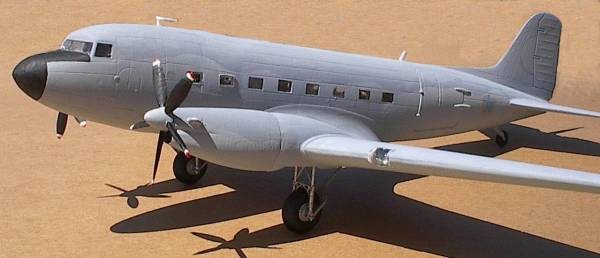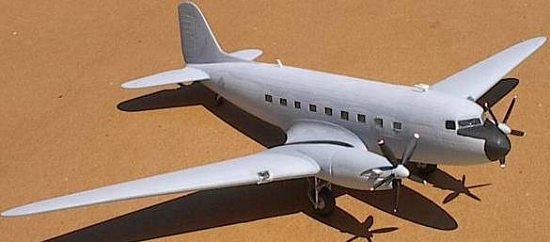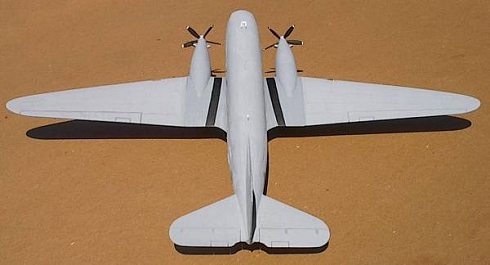
Testors/Italeri 1/72 C-47
|
KIT # |
871 |
|
PRICE: |
Italeri boxing $19.95 MSRP |
|
DECALS: |
Two Aircraft |
|
REVIEWER: |
|
|
NOTES: |
Kit decals not used. Computer-generated South African Air Force insignia were printed on inkjet decal paper. |

|
HISTORY |
This relatively old Italeri model is of the Douglas C-47 Skytrain. As the Italeri kit directions state, this airplane “…is perhaps the most famous and long-lived aircraft of all time.” Over 11,000 DC-3/C-47 aircraft were manufactured in the U.S. Japan and Russia also produced versions of the DC-3. The DC-3 first flew in 1935 and is still in commercial and military service all over the world. It appears the old “Gooney Bird” will never die.
 With
the lack of parts for the original Pratt and Whitney R-1830 piston engines, many
Dakotas are being converted to turboprops. Examples of companies that produce
turbo DC-3s are Basler Aircraft Corporation of Oshkosh, Wisconsin and Greenwich
Aircraft Corporation of Waco, Texas (see references below). The Basler
conversion is similar to the South African Air Force “Turbodak.” The Basler
conversion includes increasing cargo space by removing the radio compartment
bulkhead and stretching the original DC-3 fuselage by three and a half feet
(This is done to keep the proper balance of the plane as the turboprops are a
LOT lighter than the recips they replaced. Ed) . Basler uses Pratt &
Whitney Canada PT6A engines with Hartzell 5-bladed propellers. The Basler
Corporation website states that their turbo conversion of the DC-3 results in
43% more load carrying capability, 24% more speed, and operating costs as low as
50% of the original aircraft.
With
the lack of parts for the original Pratt and Whitney R-1830 piston engines, many
Dakotas are being converted to turboprops. Examples of companies that produce
turbo DC-3s are Basler Aircraft Corporation of Oshkosh, Wisconsin and Greenwich
Aircraft Corporation of Waco, Texas (see references below). The Basler
conversion is similar to the South African Air Force “Turbodak.” The Basler
conversion includes increasing cargo space by removing the radio compartment
bulkhead and stretching the original DC-3 fuselage by three and a half feet
(This is done to keep the proper balance of the plane as the turboprops are a
LOT lighter than the recips they replaced. Ed) . Basler uses Pratt &
Whitney Canada PT6A engines with Hartzell 5-bladed propellers. The Basler
Corporation website states that their turbo conversion of the DC-3 results in
43% more load carrying capability, 24% more speed, and operating costs as low as
50% of the original aircraft.
Turbo DC-3s are in commercial and military service throughout the world. The South African Air Force has converted over thirty of its Dakotas to “Turbodak” standards. Turbo conversions of the DC-3 also are in service in Latin American air forces. Even the U.S. Forest Service operates a few turbo conversions of the DC-3.
|
THE KIT |
The Italeri DC-3/C-47 kit has been released in many forms over the years. My 1980s vintage Testor release is molded in dark green plastic and has decals for a post-war U.S. Navy, WW-II U.S. Army Air Force, and invasion-striped RAF aircraft. This kit is currently available from both Italeri and Airfix. The Italeri DC-3 model is my kind of 1/72 scale model. It has nice engraved panel lines and relatively few parts that fit together very well. For the kit preview, see Scott Van Aken’s nice write-up on this website.
|
CONSTRUCTION |
 The
conversion to the South African Air Force “Turbodak” is straightforward. I
started with the fuselage interior. I did not spend much time on the cockpit or
cargo bay since it is very difficult to see through the small windows into the
completed model interior. Leave off the kit radio compartment bulkhead since it
is not present in “Turbodak” aircraft. Next, remove the cargo floor area that
contains the bench seats. Replace the old cargo floor with sheet plastic that
is 0.55 inches longer.
The
conversion to the South African Air Force “Turbodak” is straightforward. I
started with the fuselage interior. I did not spend much time on the cockpit or
cargo bay since it is very difficult to see through the small windows into the
completed model interior. Leave off the kit radio compartment bulkhead since it
is not present in “Turbodak” aircraft. Next, remove the cargo floor area that
contains the bench seats. Replace the old cargo floor with sheet plastic that
is 0.55 inches longer.
To stretch the fuselage, I first temporarily taped the fuselage halves together. Then I cut the fuselage, using an Xacto razor saw, along the panel line just forward of the wing leading edge. Next, I glued some plastic tabs on the inside of both the forward and aft fuselage cut lines. Then I measured the circumference of the fuselage along the cut line by wrapping a sheet of paper around it and marking with a pencil. To make the new fuselage plug, I cut a rectangular piece of sheet plastic to the measured fuselage circumference with 0.55 inch width. I formed this plastic piece into a semi-circular shape, which approximates the DC-3 fuselage cross-section, and then glued the ends together. While the glued dried on the fuselage plug, I completed the aircraft interior that was then inserted into the forward fuselage before the halves were glued together. After installing the kit windows in the aft fuselage halves, I glued those halves together. Next, I glued the new fuselage plug to the forward and aft fuselage portions. After blending the new plug into the fuselage join lines using filler and lots of sanding “elbow grease,” I cut four new windows (two on each side) into the fuselage plug using an Xacto hot knife. I made windows using clear plastic from the scrap box.
 To
convert to turboprop engines, discard all the kit parts associated with the twin
wasp engines (I am saving them to convert my Airfix Hudson to an A-28). Glue
the wing parts together, and then remove the front lip from the engine
nacelles. Make two plastic circles to match the nacelle diameter and glue one
to each nacelle. I carved my PT6 engines from basswood. I did not have any
plans of the “Turbodak.” I used photos to determine dimensions. After shaping
the engines, I glued them to the front of the engine nacelles using epoxy. I
sealed the wood using polyurethane varnish. I made the turbine engine exhaust
pipes from scrap plastic.
To
convert to turboprop engines, discard all the kit parts associated with the twin
wasp engines (I am saving them to convert my Airfix Hudson to an A-28). Glue
the wing parts together, and then remove the front lip from the engine
nacelles. Make two plastic circles to match the nacelle diameter and glue one
to each nacelle. I carved my PT6 engines from basswood. I did not have any
plans of the “Turbodak.” I used photos to determine dimensions. After shaping
the engines, I glued them to the front of the engine nacelles using epoxy. I
sealed the wood using polyurethane varnish. I made the turbine engine exhaust
pipes from scrap plastic.
The Hartzell propellers were made from scrap box parts. The spinners came from the Airfix Do-217 kit, while the propeller blades came from unidentified model that I had “deep-sixed” many moons ago. I built a jig to attach the five blades to each spinner.
|
PAINTING & MARKINGS |
I brush-painted my “Turbodak” using Testors light and dark ghost gray. I made the subdued South African Air Force insignia on my desktop computer. I first scanned a book picture of the South African Insignia into my computer, modified it to match the insignia shown on “Turbodak” photos, and then printed out the correct-size model insignia on Bel Inc. inkjet decal paper. Photos of the “Turbodak” show that the subdued insignia only are on the fuselage.
|
CONCLUSIONS |
I really enjoyed making this “Turbodak” conversion of the Italeri C-47 kit. The resulting model airplane is an interesting variation of the old “gooney bird.” For the quarter-scale buffs, this conversion could be simply done using the Monogram DC-3/C-47 kit.
|
REFERENCES |
 Basler
Turbo Conversions (http://www.Baslerturbo.com/info.html)
Basler
Turbo Conversions (http://www.Baslerturbo.com/info.html)
Greenwich Aircraft Corporation (http://members.aol.com/sanjuana/2eGACHOMEPAGE.htm)
A Tribute to the DC-3 (http://www.centercomp.com/dc3/)
The Douglas C-47 Dakota (http://www.vectorsite.net/avc47.html)
U.S. Forest Service Region 4 Smokejumper Aircraft (http://www.fs.fed.us/fire/operations/jumpers/mccall/aircraft.html)
If you would like your product reviewed fairly and quickly, please contact me or see other details in the Note to Contributors.